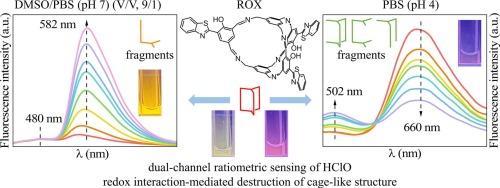基于红绿荧光有机笼的次氯酸双通道比例传感
IF 4.6
2区 化学
Q1 SPECTROSCOPY
Spectrochimica Acta Part A: Molecular and Biomolecular Spectroscopy
Pub Date : 2025-09-09
DOI:10.1016/j.saa.2025.126928
引用次数: 0
摘要
次氯酸(HClO)的高效检测对生命和环境健康至关重要,但对探针的单一荧光信号和单一传感通道仍然具有挑战性。有机笼具有很强的吸附能力和笼型结构相关的荧光性质,是一种极具潜力的荧光探针。然而,有机笼的单一信号和短发射限制了其传感性能。设计长波长双发射有机笼对HClO的双通道比例传感具有重要意义。在此,我们报道了一个有机笼(ROX)作为HClO精确定量的探针。制备的ROX在660/502 nm附近表现出胶囊拓扑促进的红/绿双发射。笼状结构被ROX中亚胺键与HClO之间的快速特异性氧化还原相互作用所破坏。结果,在PBS (pH 4)中,660nm处的荧光猝灭,502nm处的荧光增强。在DMSO/PBS (pH 7) (V/V, 9/1)溶液中,582 nm处荧光增强,480 nm处荧光恒定。PBS和DMSO/PBS的线性范围分别为1 ~ 30 μM和20 ~ 45 μM,检测限(3 s)分别为14 nM和49 nM, 10次重复检测的相对标准偏差分别为1.04%和0.54%。基于双比值的相互验证,双通道比值传感具有良好的准确度、灵敏度、选择性和精密度。此外,ROX可用于实际水和消毒液样品中的HClO监测,加标回收率为95.0% ~ 104.2%。该传感方法突出了有机笼在荧光传感中的巨大潜力。本文章由计算机程序翻译,如有差异,请以英文原文为准。

Dual-channel ratiometric sensing of hypochlorous acid based on organic cage with red and green fluorescence
The high-performance detection of hypochlorous acid (HClO) is crucial for life and environmental health, but still challenging for the single fluorescence signal and single sensing channel of probes. Organic cage with strong adsorption ability and cage structure-related fluorescence property, is a type of potential fluorescent probe. However, the single signal and short emission of organic cage hinders its sensing performance. The design of dual emitting organic cage with long wavelength for dual-channel ratiometric sensing of HClO is of great significance. Herein, we reported an organic cage (ROX) as a probe for accurate quantification of HClO. The prepared ROX exhibited capsule topology-facilitated red/green dual emission around 660/502 nm. The cage-like structure was disrupted by the rapid specific redox interaction between imine bond in ROX and HClO. As a result, the fluorescence at 660 nm quenched in conjunction with the enhancement at 502 nm in PBS (pH 4). Besides, the fluorescence increased at 582 nm with constant emission at 480 nm in DMSO/PBS (pH 7) (V/V, 9/1). The ratio signal in PBS and DMSO/PBS respectively gave the linearity range of 1–30 and 20–45 μM, the limit of detection (3 s) of 14 and 49 nM, and the relative standard deviation of 1.04 % and 0.54 % for 10 replicate determinations. Based on the mutual validation of dual ratio, the dual-channel ratiometric sensing possesses good accuracy, sensitivity, selectivity, and precision. Moreover, ROX can be applied to HClO monitoring in actual water and disinfectant samples with the recoveries of spiked HClO ranged from 95.0 % to 104.2 %. The proposed sensing method highlights the great potential of organic cage in fluorescence sensing.
求助全文
通过发布文献求助,成功后即可免费获取论文全文。
去求助
来源期刊
CiteScore
8.40
自引率
11.40%
发文量
1364
审稿时长
40 days
期刊介绍:
Spectrochimica Acta, Part A: Molecular and Biomolecular Spectroscopy (SAA) is an interdisciplinary journal which spans from basic to applied aspects of optical spectroscopy in chemistry, medicine, biology, and materials science.
The journal publishes original scientific papers that feature high-quality spectroscopic data and analysis. From the broad range of optical spectroscopies, the emphasis is on electronic, vibrational or rotational spectra of molecules, rather than on spectroscopy based on magnetic moments.
Criteria for publication in SAA are novelty, uniqueness, and outstanding quality. Routine applications of spectroscopic techniques and computational methods are not appropriate.
Topics of particular interest of Spectrochimica Acta Part A include, but are not limited to:
Spectroscopy and dynamics of bioanalytical, biomedical, environmental, and atmospheric sciences,
Novel experimental techniques or instrumentation for molecular spectroscopy,
Novel theoretical and computational methods,
Novel applications in photochemistry and photobiology,
Novel interpretational approaches as well as advances in data analysis based on electronic or vibrational spectroscopy.

 求助内容:
求助内容: 应助结果提醒方式:
应助结果提醒方式:


